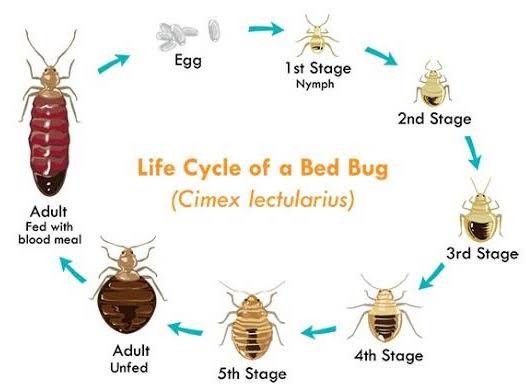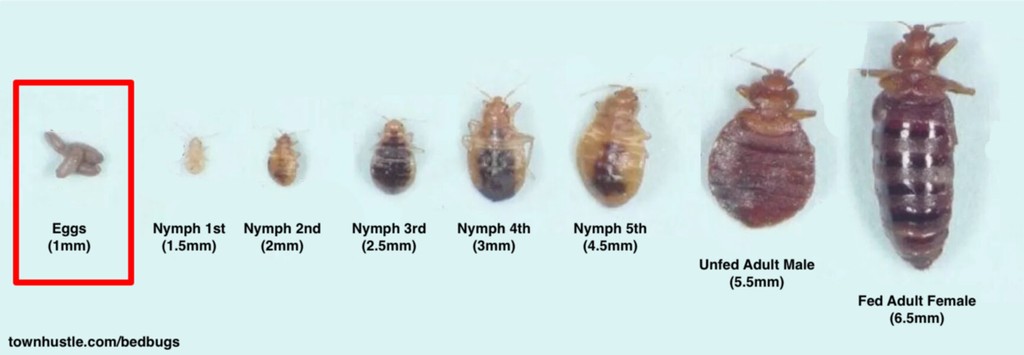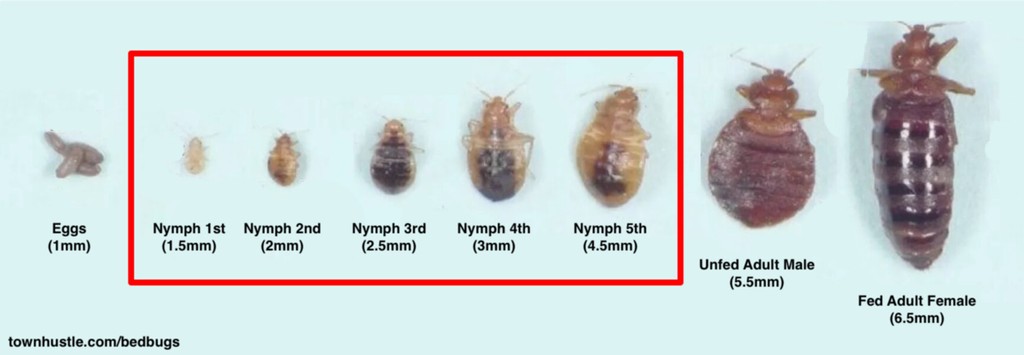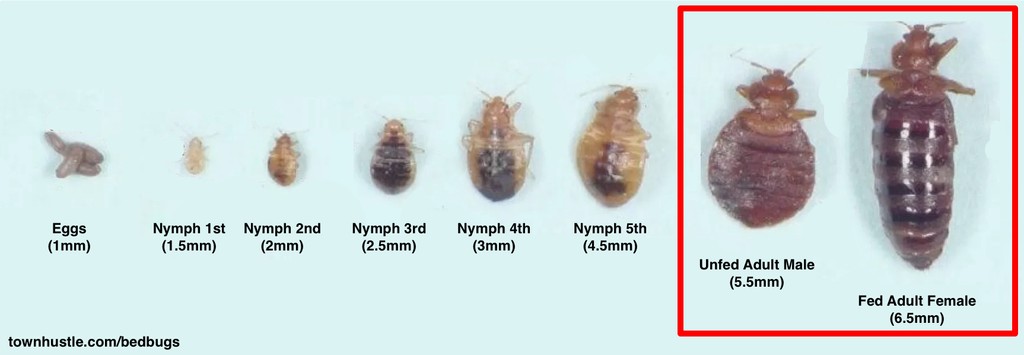Bed bugs were almost eradicated in the USA and the entire North American region in the 1950s to the1990s. Several factors have, however, led to a resurgence of bed bug infestations worldwide. Some of the factors include frequent travel, the bugs’ ability to hitchhike, and lack of sufficient public awareness. Knowing what to watch out for is the most crucial step in identifying and rooting out bed bugs from your life.
Whether it is a hotel or your home, you ought to perform frequent inspection for signs of bed bug infestations. Having knowledge on the bed bug life cycle can help in your efforts to identify and combat these contagious bugs. This post, therefore, offers all the information you need to know about a bed bug’s life cycle.
Table of Contents
Life Cycle Stages
One female bed bug can lay up to 250 eggs in a life time. These eggs hatch within 6 to 10 days. Here is a complete outline and description of a bed bug’s life cycle from the moment the female lays its eggs;
Egg Stage
Female bed bugs can lay 1 to 10 eggs per a day either in clusters or individually. It is assumed that a female may lie up to 500 eggs within one lifetime. Each egg can host one bed bug. These eggs are hidden in tight cracks and crevices and hatch into nymphs within a week depending on room temperature. It is also worth noting that the eggs have a sticking coating that allows them to easily attach to your belongings.
Egg Characteristics
- milky white color.
- approximately a millimetre in length. It is often challenging to notice them because their size is equivalent to a grain of salt.
Nymph Stage
Nymphs are young bed bugs that have to go through five molting phases before attaining full maturity. At this stage of the life cycle, the bug’s appearance is identical to an adult bed bug except for its size. At this stage, the bed bugs are not sexually mature.
For a nymph to mature into an adult bed bug, it passes through five phases of growth, shedding exoskeletons at each stage. That said, they require a blood meal to move to the next stage of growth. Under optimum conditions and a steady supply of blood, a nymph can develop into an adult bed bug within a month.
Most people are mistakenly led to believe that nymphs are not as harmful as their adult counterparts. The truth, however, is that they are just as likely to feast on your blood as the adult bed bugs. Do not be fooled by their small size.
Nymph Characteristics
- Smaller in size than a mature adult bed bug
- Translucent or possess a whitish-yellow pigment
- If unfed, they can be invisible without a microscope or a lens because of their size and pigmentation. At the 5 phases of the nymph stage, their sizes are 1.5 mm, 2 mm, 2.5 mm, 3 mm, and 4.5 mm respectively.
Adult Stage
After the 5th nymph stage, a young bed bug transforms into a sexually mature adult bed bug. Although they are capable of producing offspring at this stage, they must feed regularly in order to reproduce. It is also worth noting that adult bed bugs are hard to spot even though they are larger than nymphs. These irritating bugs are accustomed to hiding in cracks, crevices and seams of clothing and upholstery.
Adult Characteristics
- Adults bed bugs are 5mm long or 1/5 inch long. It is equivalent of the size of an apple seed.
- Fed adults are a bit longer than unfed, about 6mm long or 1/4 inch long
- They are Long, with a brown color and a flat, oval shaped body if they’ve not fed recently. Upon feeding, they become balloon-like, reddish-brown and stretched out
- Smelly with a musty sweet odor. This odor stems from glands situated on the bugs’ lower side of the body.
Bed bug breeding tendencies
To kick off a life cycle, adult bed bugs have to mate. Like other bugs in the Cimicid family bed bugs mate through a process called traumatic insemination. The male, essentially, stabs its genitalia through the female’s accessible body wall into its genitals. A female bed bug’s reproductive part is known as the Organ of Berlese.
The male bed bug releases its sperms into the female’s hemocoel (abdominal cavity). From there, the sperms diffuse via the hemolymph into its ovaries. Hemolymph is a fluid equivalent to the blood for bed bugs. Once they reach the ovaries, fertilization occurs.
How long does a bed bug’s life cycle take?
A bed bug’s transformation from an egg to a sexually mature adult can take as little as 5 weeks or as long as 4 months. There are several factors that determine the duration at which a bed bug’s life cycle can take. Some of the main factors include access to a consistent source of food and optimum room temperature.
After achieving its full size an adult bed bug can live for 6 to 12 months even without food. According to bedbuglawyer.org, bed bugs in the United States’ east coast tend to have longer lifespans owing to several factors including;
- Cooler climatic conditions
- Dense population that offers ample food source
- Stable environmental conditions
What is the gestation period for bed bugs?
Even though bed bugs are very tiny, there mating behaviors are similar to other bugs, birds, and turtles. After the eggs are laid, they undergo a gestation process that takes 6 to 10 days depending on various conditions. This is one of the reasons infestations tend to grow and spread at an alarming speed.
How long can bed bugs live without a host?
Bed bugs like human blood but, they’ve been known to feed on mammals such as bats. When needs, bedbugs are known to feed on cats and dogs. They need to feed in order to grow and multiply just like all living things. This, however, does not mean that you should live your house empty for long with the goal of kicking out an infestation. Unlike most critters, bed bugs can live without food for an astonishing amount of time.
Bed bug eggs do not need hosts at this stage. You don’t have to worry about bed bug eggs sucking on your blood because it’s the only stage that does not feed. After hatching, bed bugs need a blood meal each time they molt and move to the next stage.
Young bed bugs (nymphs), on the other hand, are less likely to survive without food compared to adult bed bugs. For a nymph to survive, it needs to feed at least once a week. This allows them to grow, molt and, achieve sexual maturity.
An adult bed bug can live for up to one year without food under favorable conditions such as cool room temperature. Without food, nymphs tend to die 50% faster than their adult counterparts. Larger, mature bed bugs develop a hunger bubble in their gut that enables them to fend off starvation.
Are bed bugs attracted to light at some stage in their life?
No, bed bugs are not attracted to light at any stage of their life cycle. They are smart critters that can resist the allure of a meal during the day. They only come out when the smell of carbon dioxide is too strong to resist. This often happens at night. Other things that often attract bed bugs include;
- Dark environment
- Histamine produced by the human body due to certain immune responses
- Fresh blood from a living host
Can bed bug detection dogs distinguish a bed bug’s life cycle stages?
According to a study by researchers from the University of Florida, canine bed bug detection has an accuracy rate of 95%. A well trained dog can not only detect dogs but also distinguish different stages of the pest’s life cycle.
Final Thoughts
Now you have some knowledge about a bed bug’s life cycle and how they multiply from a single bug to thousands a short time. This information will help you deal with bed bugs appropriately and prevent them from interfering with your life. To conclude this informative post, here are a few quick facts about bed bugs that you should know;
- Both nymphs and adult bed bugs generally feed at night
- Older stages of nymphs can stay alive longer without food compared to young ones
- Managing bed bugs at different stages of their lifecycle requires comprehensive guidance and understanding




